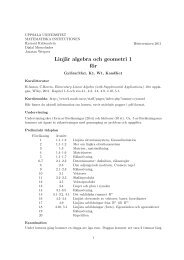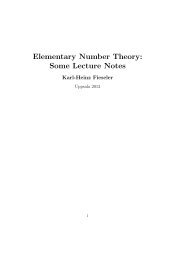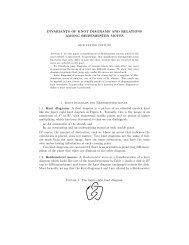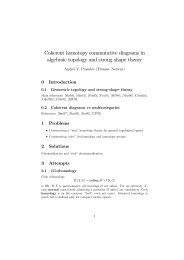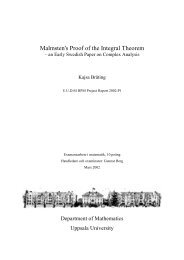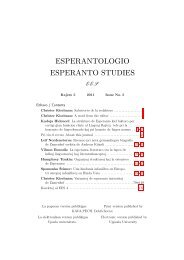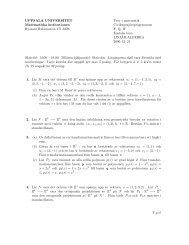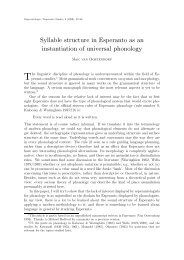Simple weight sl(2)-modules and their tensor products - DiVA
Simple weight sl(2)-modules and their tensor products - DiVA
Simple weight sl(2)-modules and their tensor products - DiVA
You also want an ePaper? Increase the reach of your titles
YUMPU automatically turns print PDFs into web optimized ePapers that Google loves.
<strong>Simple</strong> <strong>weight</strong> <strong>sl</strong>(2)-<strong>modules</strong><strong>and</strong> <strong>their</strong> <strong>tensor</strong> <strong>products</strong>Uppsala UniversitetAntoine DurdekMay 20, 2008
Contents1 Theory about the <strong>sl</strong>(2) Lie Algebra 41.1 Denitions . . . . . . . . . . . . . . . . . . . . . . . . . . 41.1.1 Lie Algebra . . . . . . . . . . . . . . . . . . . . . 41.1.2 Universal enveloping algebra . . . . . . . . . . . . 71.1.3 The Lie algebra <strong>sl</strong>(2) . . . . . . . . . . . . . . . . 91.1.4 Casimir operator . . . . . . . . . . . . . . . . . . 101.2 Finite dimensional <strong>sl</strong>(2)-<strong>modules</strong> . . . . . . . . . . . . . 111.2.1 Structure of module generated by a primitive element 111.2.2 Decomposition of nite dimensional module . . . 152 Application 212.1 About the <strong>tensor</strong> product . . . . . . . . . . . . . . . . . 212.1.1 The general answer . . . . . . . . . . . . . . . . . 212.1.2 An example . . . . . . . . . . . . . . . . . . . . . 222.1.3 Generalization . . . . . . . . . . . . . . . . . . . . 222.2 An example of innite dimensional <strong>sl</strong>(2)-module . . . . . 232.2.1 Construction of an innite dimensional <strong>sl</strong>(2)-module 232.2.2 Study of this module . . . . . . . . . . . . . . . . 242.2.3 Tensor product with W 1 . . . . . . . . . . . . . . 262.2.4 Action of C on this module . . . . . . . . . . . . 272.2.5 Generalization . . . . . . . . . . . . . . . . . . . . 313
1 Theory about the <strong>sl</strong>(2) LieAlgebra1.1 Denitions1.1.1 Lie AlgebraDenition 1 A Lie algebra g is a vector space together with a skewsymmetric bilinear map[ , ] : g × g → g (1.1)satisfying the Jacobi identity, where the Jacobi identity is:[X, [Y, Z]] + [Y, [Z, X]] + [Z, [X, Y ]] = 0 (1.2)for all vectors X,Y <strong>and</strong> Z in g. The product [x, y] is called the Lie bracketor just bracket.Remark 1 1. We can see that a Lie Algebra g is neither associativenor unitary.2. We can dene in a very natural way the notion of Lie subalgebra.Let us say that h is a subalgebra of g if h is a subvector space of g<strong>and</strong> if h is stable for the bracket operation. Thus h has a structureof Lie algebra.Example 1 1. The rst example that we can give is maybe the easiestone. Let E be a vector space <strong>and</strong> dene [x, y] = 0 for all x, y ∈ E.This denition satises all the points of the denition of Lie algebra.Such a Lie algebra is called an abelian algebra.2. Let (A, •) be an associative algebra (in the usual sense) <strong>and</strong> dene[x, y] = x • y − y • x∀x, y ∈ AThis bracket operation is clearly bilinear <strong>and</strong> skew symmetric. Letus verify for a rst calculation that A is a Lie algebra by calculating4
the Jacobi identity:[x, [y, z]] + [y, [z, x]] + [z, [x, y]]= [x, y • z − z • y] + [y, z • x − x • z] + [z, x • y − y • x]= (x • y • z − x • z • y − y • z • x + z • y • x)+(y • z • x − y • x • z − z • x • y + x • z • y)+(z • x • y − z • y • x − x • y • z + y • x • z)= 03. For example we can take the associative algebra of matrix of sizen, M n (C) with the matrix product. The Lie algebra correspondingis called gl(n). For a special Lie subalgebra of gl(n) we will look atthe subspace of matrix with trace zero, <strong>sl</strong>(n). We can verify veryquickly that this subspace is stable under the bracket operation, onlyby using the property of the trace from linear algebra.Let A, B be two elements of <strong>sl</strong>(n), we just need to show T r([A, B]) = 0T r([A, B]) = T r(AB − BA)= T r(AB) − T r(BA)= T r(AB) − T r(AB)= 0What is a Lie algebra of dimension one or two over the complex eld C?• Let L be a Lie algebra of dimension one. Then L =< l > <strong>and</strong> thebracket operation forced L to be abelian 1 . Thus we have just:L = {λl|λ ∈ C}Then L is isomorphic to the Lie algebra associated with (C, ·).• Let now L be a Lie algebra of dimension two. L =< l 1 , l 2 >. Wehave of course [l i , l i ] = 0, i = 1, 2 <strong>and</strong> then L is only determined bythe bracket [l 1 , l 2 ]. We have two dierent cases.Case 1 [l 1 , l 2 ] = 0Then we have here that all the brackets are zero, <strong>and</strong> then L isabelian. We can conclude by saying that L is isomorphic to C 2 .Case 1 [l 1 , l 2 ] ≠ 0Then we obtain an element of L, say for example that [l 1 , l 2 ] = l =1 [l, l] = 0 because [ , ] is skew symmetric5
al 1 +bl 2 ∈ L. We can work a little bit around this equation in orderto have a nicer way to describe this Lie algebra.The image of the bracket is one dimensional, so we can change thebasis in order to have the result of the bracket equal to the rstvector of the basis. We know that [l 1 , l 2 ] = al 1 + bl 2 ≠ 0. Thenwithout losing of generalities 2 , we have a ≠ 0. Then let us rechoosethe basis by writing:l ′ 1 := al 1 + bl 2l ′ 2 := 1 a l 2thus [l 1, ′ l 2] ′ = [al 1 + bl 2 , 1 a l 2]= [al 1 , 1 a l 2]= [l 1 , l 2 ]= al 1 + bl 2= l ′ 1This bracket completely determines L which is the unique nonabelianLie algebra of dimension two over C.Now we would like to classify dierent kinds of Lie algebra but we needa crop of denitions. We can dene for a Lie algebra the notion of idealas for a classical algebra. We say that the Lie subalgebra h of g is anideal if it satises :[x, y] ∈ h, for all x ∈ h <strong>and</strong> y ∈ gMoreover, we can say as for an algebra that we have the equivalencebetween:g/h is an Lie subalgebra ⇔ h is an ideal of gWe can dene two descending chains of subalgebras which are calledthe lower central series {D k g} <strong>and</strong> the derivated series { D k g } . Wedene them by induction.D 1 g = [g, g]D k g = [g, D k−1 g]2 if a = 0 then b ≠ 0 <strong>and</strong> after permuting l 1 <strong>and</strong> l 2 , we have a ≠ 06
<strong>and</strong>D 1 g = [g, g]D k g = [D k−1 g, D k−1 g]Denition 2 Let g be a Lie algebra.• We say that g is simple if g contains no nontrivial ideal <strong>and</strong> dim g ≥2• We say that g is nilpotent if D k g = 0 for some k• We say that g is solvable if D k g = 0 for some k• We say that g is semisimple if g has no nonzero solvable idealsExample 2 1. An example of simple Lie algebra is <strong>sl</strong>(2) <strong>and</strong> <strong>sl</strong>(n) ingeneral with n ≥ 22. A nilpotent algebra is the algebra of strictly upper-triangular matrixof size n, U n C. Of course, abelian Lie algebras are nilpotent algebrastoo (k=1).3. An example of solvable Lie algebra is given by the algebra of uppertriangularmatrix of size n. Of course we have that any nilpotentalgebra is a solvable algebra.4. A semi simple algebra is isomorphic to a product of simple algebra.1.1.2 Universal enveloping algebraWe have seen in the rst example (2), how to build a Lie algebra froman associative algebra. In this section, we want to reverse the problem,i.e. we want from a Lie algebra L over the complex to obtain an associativealgebra U(L) with unity <strong>and</strong> with the property that the bracketoperation in U(L) corresponds to the bracket in L. This algebra is calledthe Universal enveloping algebra <strong>and</strong> is really bigger than L. We willbuild up to isomorphism a such algebra.7
Construction of the Universal enveloping algebraWe can construct very explicitely the universal enveloping algebra. It isthe quotient of the <strong>tensor</strong> algebra of L by a two-sided ideal. The <strong>tensor</strong>algebra T (L) of a Lie algebra is dened as below:T (L) = ⊕ ∞ i=0T i (L)where T i (L) = L ⊗(i)= L ⊗ . . . ⊗ L} {{ }i times<strong>and</strong> T 0 (L) = CWe dene the multiplication m on T (L) by:m : T (L) × T (L) −→ T (L)(a, b) ↦−→ m(a, b) = a ⊗ bwhere a ∈ T i (L) <strong>and</strong> b ∈ T j (L) <strong>and</strong> m(a, b) ∈ T i+j (L)We dene the two-sided ideal I by its generator:I =< a ⊗ b − b ⊗ a − [a, b] | for all a <strong>and</strong> b in L >Then we can write : U(L) = T (L)/I.Moreover, the canonical injection L ↩→ T (L) denes a morphismι : L → U(L)The universal enveloping algebra built as above satises the Universal property 3 .Recall that the universal property can be written as:U(L) is the unique associative algebra such that for each associative algebraA <strong>and</strong> all Lie algebra morphism φ : L → A, there is a uniqueassociative algebra morphism ψ such that the diagramm commutes, i.e.φ = ψ ◦ ιLι↩→φ ↘U(L)↓ ψA3 it explains why we call this algebra, "universal" enveloping algebra8
1.1.3 The Lie algebra <strong>sl</strong>(2)In this section, we will detail <strong>and</strong> present the Lie algebra <strong>sl</strong>(2) which willbe the example in all the next sections.First, we can explain a basis of <strong>sl</strong>(2). <strong>sl</strong>(2) is the space of the squarematrixof size 2 with trace null. The dimension of <strong>sl</strong>(2) is three 4 , hence abasis is, for example:( ) 1 0H =0 −1( ) 0 1X =0 0( ) 0 0Y =1 0And we have the following relations:[H, X] = 2X, [H, Y ] = −2Y, [X, Y ] = H (1.3)The relations (1.3)are the only relations we need to verify to have a <strong>sl</strong>(2)-structure. It is necessary to know the representation of <strong>sl</strong>(2) to study itsstructure.Denition 3 A representation of <strong>sl</strong>(2) is a morphism ρ : <strong>sl</strong>(2) → GL(V )for some vector space V over C. The dimension of V is called the degreeof ρ.We know from representation theory that the notion of representationof g <strong>and</strong> the notion of g −module are equivalent. Here we will only carryon the module point of view. Recall that a g − module is a vector spaceV, endowed with a linear g-action, g × V → V . We gp through from oneto the other by deningρ l (v) def= lvwhere the left side corresponds to representation <strong>and</strong> right side to g-module structure. This preliminaries justify the fact that we will studythe <strong>sl</strong>(2)-<strong>modules</strong>.Let V be an <strong>sl</strong>(2)-module. We dene V λ the eigenspace of V relativelyto H for the eigenvalue λ, i.e. the set of all x ∈ V such that Hx = λx.An element of V λ is called of <strong>weight</strong> λ.Theorem 41. ∑ λ∈C V λ is a direct sum.4 the four entries in the matrix <strong>and</strong> one condition for the trace, so 4 − 1 = 39
2. if v ∈ V λ , then Xv ∈ V λ+2 <strong>and</strong> Y v ∈ V λ−2Proof1. To prove the rst part of the theorem, we just have to show that theintersection of two dierent V λ for dierent eigenvalues is only {0}.It is clearly true, because eigenvector are linearly independant, i.e.if v ≠ 0, then v /∈ V λ ∩ V µ for λ ≠ µ.2. Let v ∈ V λ . Then Hv = λv. Thus we have:HXv = [H, X]v + XHv= 2Xv + Xλv= (λ + 2)XvBy the same way, we have that HY v = (λ − 2)Y v, which endedthe proof.□1.1.4 Casimir operatorWe will dene an element in the universal enveloping algebra U(<strong>sl</strong>(2))called the Casimir operator <strong>and</strong> denoted by C: C = H 2 +1+2XY +2Y X.Of course we can write it by dierent way:C = H 2 + 1 + 2XY + 2Y X= H 2 + 1 + 2XY + 2([Y, X] + XY )= H 2 + 1 + 2XY + 2(−H + XY )= (H − 1) 2 + 4XYBy the same way, we can show that C = (H + 1) 2 + 4Y X.We will prove now that C is in the center of the universal enveloping.To proove this assertion, we just need to show that C commutes withevery element of a basis of <strong>sl</strong>(2) <strong>and</strong> thus, it will commute with anyelement of U(<strong>sl</strong>(2)).HXY = [H, X] Y + CHY= 2XY + X [H, Y ] + XY H= 2XY − 2XY + XY H= XY H10
By a similar way, we can easily obtain HY X = Y XH Hence,H · C = H · (H 2 + 1 + 2XY + 2Y X)= H 3 + H + 2HXY + 2HY X= H 3 + H + 2XY H + 2Y XH= (H 2 + 1 + 2XY + 2Y X) · H= C · HSo H <strong>and</strong> C commute.X · C = X · (H 2 + 1 + 2XY + 2Y X)= XH 2 + X + 2X 2 Y + 2XY X= [X, H] H + HXH + X + 2(X [X, Y ] + XY X) + 2XY X= −2XH + H [X, H] + H 2 X + X + 2(XH + [X, Y ] X + Y X 2 ) + 2XY X= −2XH − 2HX + H 2 X + X + 2(XH + HX + Y X 2 ) + 2XY X= H 2 X + X + 2Y X 2 + 2XY X= (H 2 + 1 + 2XY + 2Y X) · X= C · XSo C <strong>and</strong> X commtute too. We can nish by proving that C <strong>and</strong> Ycommute by exactly the same calculation as above for X ·C. So, we haveC in the center of our universal enveloping.We will not need it but wecan say that in general, C can be construct by choosing a basis of ourLie algebra <strong>and</strong> a bilinear form (the Killing form for example), <strong>and</strong> toconstruct a basis for the dual with respect to this form. Then we justdene C as:C = ∑ x i · x ∗ iIn the case of a simple Lie algebra, we have by Schur's lemma that C isproportional to the identity.1.2 Finite dimensional <strong>sl</strong>(2)-<strong>modules</strong>1.2.1 Structure of module generated by a primitiveelementDenition 5 The subalgebra of <strong>sl</strong>(2) generated by H <strong>and</strong> X is calledBorel algebra <strong>and</strong> is denoted B.11
Theorem 6 B is solvableProofB = 〈X, H〉In order to prove that B is solvable, we need to show that it exists a ksuch that D k B = 0. Recall that D 1 B = [B, B] = {[x, y]|x, y ∈ B} Inthis case we have that :[x, y] = [λ 1 H + µ 1 X, λ 2 H + µ 2 X]= λ 1 λ 2 [H, H] + λ 1 µ 2 [H, X] + λ 2 µ 1 [X, H] + µ 1 µ 2 [X, X]= 0 + 2λ 1 µ 2 X − 2λ 2 µ 1 X + 0= λ · Xfor some λ ∈ C. Then D 1 B = {λ · X|λ ∈ C} <strong>and</strong> thus D 2 B = 0Denition 7 Let V be an <strong>sl</strong>(2)-module <strong>and</strong> let λ ∈ C. A non-zero elementv ∈ V is called primitive of <strong>weight</strong> λ if it satises:Xv = 0, Hv = λv (1.4)Theorem 8 A non-zero element v ∈ V is primitive if <strong>and</strong> only if theline generated by v is stable for the Borel algebra B.ProofLet v be primitive. Then we have:□Xv = 0,Hv = λvAnd thus, the line generated be v is stable for B. Reciproquely, let C · vbe stable for the action of B. Then we have Hv = λv <strong>and</strong> Xv = µv,λ, µ ∈ C.T hus 2µ = 0[H, X]v = 2Xv = 2µv= HXv − XHv= Hµv − Xλv= λµv − µλv = 0It means that Xv=0 <strong>and</strong> thus that v is primitive.□12
Theorem 9 Let V be an <strong>sl</strong>(2)-module <strong>and</strong> v ∈ V be a primitive elementof <strong>weight</strong> λ. Denote v n = Y n v/n! for n ≥ 0 <strong>and</strong> v −1 = 0. Then we have:1. Hv n = (λ − 2n)v n2. Y v n = (n + 1)v n+13. Xv n = (λ − n + 1)v n−1for all n ≥ 0Proof1.n! · Hv n = HY n v= [H, Y ]Y n−1 v + Y HY n−1 v= −2Y n v + Y [H, Y ]Y n−2 v + Y 2 HY n 2v= · · ·= −2nY n v + Y n Hv= −2nv n n! + Y n λv= (λ − 2n)v n · n!Then by divising by n! we have the expression of Hv n .2.Y v n = Y · Y n v/n!= (n + 1)Y n+1 v/(n + 1)!= (n + 1)v n+13. For this case, we will do it by induction on n.Xv 0 = Xv = 0because v is primitive <strong>and</strong> with the convention that v −1 = 0.nXv n = XY v n−1= [X, Y ]v n−1 + Y Xv n−1= Hv n−1 + (λ − n + 2)Y v n−2= (λ − 2n + 2 + (λ − n + 2)(n − 1))v n−1= n(λ − n + 1)v n−113
Then by divising by n, we obtain the expression we were lookingfor.Theorem 10 There are only two dierent cases:1. All the (e n ) n∈N are linearly independant2. It exists an integer m such that λ = m. Moreover e i = 0, ∀i ≥ m+1<strong>and</strong> e 0 , · · · , e m are linearly independantProof First of all, the fact that the (e n ) n are linearly independant isclearly true because the e n have dierent <strong>weight</strong>s (or belong to dierenteigenspace). Then now we have two dierent cases: all the e n ≠ 0 orthere is an integer m such that e m+1 = 0, which are the dierent cases ofthe theorem. Furthermore, in the second case, we have e i = 0, ∀i ≥ m+1because of the action of Y . The action of X ends the proof:Xe m+1 = (λ − m)e m e m is a non-zero vector= 0thus λ − m = 0λ = m□Theorem 11 Let V be a nite dimensional <strong>sl</strong>(2)-module <strong>and</strong> let v ∈ Vbe a primitive element.Then the submodule of V generated by v is an irreducible <strong>sl</strong>(2)-module.Proof V is nite dimensional, then of course, we are in the second caseof the preceding theorem. Let m be the <strong>weight</strong> of v <strong>and</strong> denote W = 〈v〉the submodule of V generated by v.We claim that W contains v i , for all i between 0 <strong>and</strong> m. In fact, Wis an <strong>sl</strong>(2)-module, therefore it is stable for the action of H,X <strong>and</strong> Y .By theorem (9), the relations (<strong>and</strong> more precisely the action of X <strong>and</strong>Y ) imply that W contains all of this vectors.In order to prove that W is irreducible, let W ′ be a non-zero submoduleof W . Because W ′ is non-zero, it contains one of the v i . Once again weuse the theorem (9) to say that it contains v i+1 , · · · , v m by the action ofY <strong>and</strong> v i−1 , · · · , v 0 by the action of X. And hence we have W = W ′ ,which means that W is irreducible.□□14
1.2.2 Decomposition of nite dimensional moduleIn this section, we will see an important result about <strong>sl</strong>(2)-module. It isthe fact that every nite dimensional module can be decomposed into a(direct) sum of irreducible module. Before that, we will just describe thestructure of an irreducible <strong>sl</strong>(2)-module of dimension m + 1.Denition 12 Let m ≥ 0 <strong>and</strong> W m be a vector space, together with abasis v 0 , · · · , v m . We equipped W m as the irreducible module seen in thepreceding section with the following relations:1. Hv n = (m − 2n)v n2. Y v n = (n + 1)v n+13. Xv n = (m − n + 1)v n−1with the convention that v −1 = 0 = v m+1 .Theorem 13 W m is an irreducible <strong>sl</strong>(2)-module of dimension m + 1.Proof To show this we just need to check the <strong>sl</strong>(2) relations (1.3).[H, Y ]v n = (n + 1)Hv n+1 − (m − 2n)Y v n= (n + 1)(m − 2n − 2)v n+1 − (m − 2n)(n + 1)v n+1= −2(n + 1)v n+1= −2Y v n[H, X] v n = (m − n + 1)Hv n−1 − (m − 2n)Xv n= (m − n + 1)(m − 2n + 2)v n−1 − (m − 2n)(m − n + 1)v n−1= 2(m − n + 1)v n−1= 2Xv n[X, Y ] v n = (n + 1)Xv n+1 − (m − n + 1)Y v n−1= (n + 1)(m − n)v n − (m − n + 1)nv n= (m − n − n)v m= (m − 2n)v n= Hv nAnd thus the relations are true <strong>and</strong> W m is an <strong>sl</strong>(2)-module of dimensionm + 1.Theorem 14 Every irreducible <strong>sl</strong>(2)-module of dimension m + 1 is isomorphicto W m .□15
Proof Let V be an irreducible <strong>sl</strong>(2)-module of dimension m + 1. Weclaim that it exists a primitive element in V . In fact, let x ∈ V be aneigenvector of H <strong>and</strong> consider the sequence x, Xx, X 2 x, · · · As we haveproved in theorem (4), Xx (<strong>and</strong> thus X 2 x, · · · ) is still an eigenvector forH with a dierent eigenvalue. It follows that we have an innite sequenceof linearly independant vectors in a nite dimensional module. Of courseone of the X k x is a null vector. Take the smallest k such that X k x = 0,then X k−1 x := v is our primitive element!The theorem (10) shows that the <strong>weight</strong> of v is an integer m ′ . Let W bethe submodule of V generated by v. We know from the preceding sectionthat dim W = m ′ + 1 <strong>and</strong> W is irreducible. But V is irreducible too, <strong>and</strong>W is a submodule of V . Then of course, V = W <strong>and</strong> hence m ′ = m.Then the relations in the denition show that V is isomorphic to W m .Example 3 1. W 0 is the module with only one vector v 0 <strong>and</strong> the followingrelations:Hv 0 = v 0 , Y v 0 = 0, Xv 0 = 0It is the trivial <strong>sl</strong>(2)-module.2. W 1 is the irreducible module of dimension 2. If we note the vectorof W 1 , w 1 , w −1 instead of v 0 , v 1 respectively, it is easier to write theaction of H. Let V 1 <strong>and</strong> V −1 the eigenspace corresponding. Thenwe have:□Hw 1 = w 1Hw −1 = −w −1Xw 1 = 0Xw −1 = w 1Y w 1 = w −1Y w −1 = 0Then we can represent the action of <strong>sl</strong>(2) on W 1 by the action ofH, X <strong>and</strong> Y on the eigenspaces.XV −1 ←− V 1 Y H H16
To conclude, we can say that W 1 is isomorphic to C 2 seen as an<strong>sl</strong>(2)-module. Let us remind that if v ∈ C 2 is an eigenvector ofH, with eigenvalue λ, then Xv (resp. Y v) is still eigenvector witheigenvalue λ + 2 (resp. λ − 2).3. <strong>sl</strong>(2) viewed as an <strong>sl</strong>(2)-module by the adjoint representation isisomorphic to W 2 . We will detail this example a little bit longer inthe following paragraph.We recall that <strong>sl</strong>(2)-module <strong>and</strong> representation of <strong>sl</strong>(2) are equivalentnotions to justify that <strong>sl</strong>(2) can be seen as an <strong>sl</strong>(2)-module. We denethe adjoint represention as below:ad : <strong>sl</strong>(2) × <strong>sl</strong>(2) −→ <strong>sl</strong>(2) (g, h) ↦−→ ad(g)(h) := [g, h]The adjoint representation is in fact a representation through the equalitywhich preserves the bracket operation:[ad(x), ad(y)](z) = ad(x) ◦ ad(y)(z) − ad(y) ◦ ad(x)(z)= ad(x)([y, z]) − ad(y)([x, z])= [x, [y, z]] + [y, [z, x]]= −[z, [x, y]] by the Jacoby identity= [[x, y], z]= ad([x, y])(z)It is enough to consider the action of H to determine the isomorphism φbetween <strong>sl</strong>(2) <strong>and</strong> W 2 . Indeed, in the one h<strong>and</strong>, we have the relations:ad(H)(H) = [H, H] = 0ad(H)(X) = 2Xad(H)(Y ) = −2Y<strong>and</strong> thus we have ad(H) =the action of H on W 2 :⎛0 0⎞0⎝0 2 0 ⎠. In the other h<strong>and</strong>, we have0 0 −2Hv 0 = 2v 0Hv 1 = 0Hv 2 = −2v 2<strong>and</strong> thus φ maps: H ↦→ v 1 X ↦→ v 0 <strong>and</strong> Y ↦→ v 2 .We come now to the main result about the complete reducibility of <strong>sl</strong>(2)-<strong>modules</strong>.17
Theorem 15 Every nite dimensional <strong>sl</strong>(2)-module V can be written asa direct sum of irreducible <strong>modules</strong>. In other words:for each nite dimensional module V, there exists integer (m i ) i∈I suchthatV = ∑ W mii∈IProof Let V be a nite dimensional <strong>sl</strong>(2)-module.We can decompose V in terms of generalized eigenspaces for the Casimiroperator C. Then we have:V = ∑ θ∈CV θwhereV θ = { v ∈ V |∃k ∈ N s. th. (C − θ) k v = 0 }This spaces are all <strong>sl</strong>(2)-<strong>modules</strong>. Indeed C commutes with every elementof <strong>sl</strong>(2), thus it means that V θ is stable for the action of <strong>sl</strong>(2) as we cansee:Let v ∈ V θ <strong>and</strong> Z ∈ <strong>sl</strong>(2)(C − θ) k Zv = Z(C − θ) k v= Z · 0= 0⇒Zv ∈ V θ<strong>and</strong> the relations are satised because V θ is a subspace of V .Now we can say that an irreducible module of V θ have dimension √ θ.In fact, let v be a primitive element in V θ ,then(C − θ)v = ((H + 1) 2 + 4Y X − θ)v= (H + 1) 2 v − θv= 0T hus (H + 1)v = √ θvHv = ( √ θ − 1)vThen v is of <strong>weight</strong> √ θ −1 which means that 〈v〉 = W (√θ−1)of dimension√θ. For reason of notation we will write k :=√θ − 1 (or θ = (k + 1) 2 ).18
Then we just need to prove that we can decompose V θ into irreducible<strong>modules</strong>; indeed V is a sum of V θ so if we can write them as a sum ofirreducible module, it will nish the proof. We will do it by induction onthe number of copy of W k in V θ .• Case n=2Let v be a primitive element. Then 〈v〉 := W . Let x be a primitiveelement of V θ /W . We have W, V θ /W ∼ = W k . We dene abasis of W (resp. V θ /W ) by the sequence (v 0 , Y v 0 , · · · , Y k v 0 ) =(v 0 , v 1 , · · · , v k ) (resp.(x 0 , Y x 0 , · · · , Y k x 0 ) = (x 0 , x 1 , · · · , x k )). Thenwe write [C] k−2i the matrix of C on the eigenspace V k−2i = 〈v i , x i 〉.We just need to show that for each i ∈ [0, k], [C] k−2i is diagonalizable.Because of our denition, we have that [Y i ] = id for each i.Then we have:[Y k C] = [Y k ] · [C] k= [C] k[Y k C ] = [CY k ] because C <strong>and</strong> Y commute= [C] −k [Y k ]= [C] −kBut in the special case of [C] k <strong>and</strong> [C] −k , we can explicitate thematrices. Indeed, we have:[C] k = [(H + 1) 2 + 4Y X] k= [(H + 1) 2 ] k[C] −k= [(H − 1) 2 + 4XY ] −k= [(H − 1) 2 ] −kWe claim that [H] λ = [H] λ+2 − 2 5 Then we can conclude:[C] −k = [(H − 1) 2 ] −k= [(H − 2k − 1) 2 ] k= [C] k= [(H + 1) 2 ] kThus [(H − 2k − 1) 2 ] k = [(H + 1) 2 ] k[2(−2k − 1)H + 4k 2 + 4k ] k= [2H] k[(4k + 4)H] k= k(4k + 4)[H] k= k because k ≠ −15 Just write in terms of matrices the equality HY = Y H − 2Y19
=⇒ [C] k = [(H + 1) 2 ] k=⇒ [C] k = (k + 1) 2=⇒ [C] k = θThen C = θ, <strong>and</strong> thus v <strong>and</strong> x are linearly independant for theaction of C. Then V θ∼ = W ⊕ Vθ /W <strong>and</strong> thus V θ∼ = Wk ⊕ W k .• Case n ≥ 3Let W be a submodule of V θ containing (n-1) copies of W k . ThenV θ /W ∼ = W k . By induction hypothesis we can write W as:W = W k ⊕ · · · ⊕ W k} {{ }n−1timesThen we can repeat the rst step (n-1) times with the quotient module<strong>and</strong> the copies <strong>and</strong> we obtain that V θ /W is linearly independantwith the other <strong>modules</strong> <strong>and</strong> thus we have the decomposition of V θ .□20
2 Application2.1 About the <strong>tensor</strong> productWe have seen in the theorical part that we can decompose every nitedimensional <strong>sl</strong>(2)-module into a (direct) sum of irreducible module W i(of dimension i+1). We will illustrate this result by an example: thegeneral decomposition of the <strong>tensor</strong> product of two irreducible <strong>modules</strong>.2.1.1 The general answerTheorem 16 Let n <strong>and</strong> m be two integers, such that n ≥ m. Let W n<strong>and</strong> W m be the irreducible <strong>sl</strong>(2)-module <strong>and</strong> V = W n ⊗ W m the <strong>tensor</strong>product associated with this two <strong>modules</strong>.Then,W m ⊗ W n∼ =m∑i=−mW n+iProof First of all, let v = (v 0 , . . . , v n ) (resp. w = (w 0 , . . . , w m ) )be a basisof W n (resp W m ). Let us recall that W i is an <strong>sl</strong>(2)-module of dimensioni + 1 if:• w = (w 0 , ..., w i ) is a basis of W i• H(w j ) = (i − 2 · j) · w j• X(w j ) = (i − j + 1) · w j−1• Y (w j ) = (i + 1) · w j+1We know from the theory that the eigenvalue for H of the <strong>sl</strong>(2)- moduleW n are the integers −n, −n + 2, . . . , n − 2, n (with eigenvector the w i ).We can explain a basis of V = W n ⊗ W m :(v i ⊗ w j ) for all (i, j) such that 0 ≤ i ≤ n <strong>and</strong> 0 ≤ j ≤ mWe can rst look at the action of H on v i ⊗ w j .H(v i ⊗ w j ) = H(v i ) ⊗ w j + v i ⊗ H(w j )= (n − 2i) · v i ⊗ w j + (m − 2j) · v i ⊗ w j= (n + m − 2(i + j)) · v i ⊗ w j21
Then we see that v i ⊗ w j is still an eigenvector for H with eigenvalue thesum of the eigenvalue of v i <strong>and</strong> w j . Thus the eigenvalue of W n ⊗ W mare in the set −n − m, −n − m + 2, . . . , n + m. We just need to computethe multiplicity of the eigenvalue by a dimensional argument 1 . Withoutlosing of generality, we can assume n ≥ m. { The multiplicity of thek + 1 if k ≤ meigenvalue n + m − 2k for k ∈ 0, . . . , n + m is :m + 1 if k ≥ mTo have this result, we just need to compute the dierent vectors whichhave this eigenvalue. Thus, by induction, one shows that W n ⊗ W m isisomorphic to W n+m ⊕ W n+m−2 ⊕ . . . ⊕ W n−m . We can notice that ofcourse this isomorphism preserves the dimension:(n + 1) · (m + 1) =m∑n + m − 2k + 1k=0We will not precise the isomorphism <strong>and</strong> how to get this decomposition.□2.1.2 An exampleLet n = 2 <strong>and</strong> m = 2.Then we have W 2 ⊗ W 2∼ = W4 ⊕ W 2 ⊕ W 0∼ = W4 ⊕ W 2In this case we can formulate the isomorphism between this <strong>sl</strong>(2)-<strong>modules</strong>.We just need to nd an element with eigenvalue 4 (or −4) <strong>and</strong> to lookat the module generated by this element, in the sense that we look atthe action of H,X <strong>and</strong> Y. The module we obtained is clearly isomorphicto W 4 . Then the complement of this module will be isomorphic to W 2 .An eigenvector w such that H(w) = 4 · w is for example w 2 ⊗ w 2 (withthe same notation as befor). Then < w > ∼ = W 4 . A generator of thecomplement can be for example w 0 ⊗ w 1 − w 1 ⊗ w 0 .2.1.3 GeneralizationIn the rst section, we have seen the decomposition of the <strong>tensor</strong> productof two irreducible <strong>sl</strong>(2)-<strong>modules</strong>. We can deduce in a more generalcase that for arbitrary nite dimensional <strong>modules</strong>, the decomposition of<strong>their</strong> <strong>tensor</strong> product follows directly from the theorem (2.1.1) <strong>and</strong> usingthe additiviy of the <strong>tensor</strong> product, i.e. in other words we can write1 we have a basis of eigenvectors22
explicitely:V ⊗ W =n∑W li ⊗m∑i=0 j=0W kj= ∑ i,j= ∑ i,jW li ⊗ W kjτ(i,j)∑p=0W |li −k j |+2p where τ(i, j) := l i + k j − |l i − k j |2All the sums in the preceding calculation are of course direct as we haveseen in (2.1.1).2.2 An example of innite dimensional<strong>sl</strong>(2)-module2.2.1 Construction of an innite dimensional<strong>sl</strong>(2)-moduleWe will now dene a vector space with some relations. In this section wewill just show that this space is an <strong>sl</strong>(2)-module.Denition 17 Let V (λ, c) be a innite dimensional vector space withbasis (v i ) i∈Z . We dene on V (λ, c) the following relations:• H(v i ) = (λ + 2i) · v i• Y (v i ) = v i−1• X(v i ) = α(i) · v i+1 where α(i) := c−(λ+2i+1)24.The value of λ <strong>and</strong> c are complex, they are just elements in our eld.Theorem 181. V (λ, c) is an <strong>sl</strong>(2)-module.2. C(v i ) = c · v i where C is the Casimir operatorProof1. To prove that we have an <strong>sl</strong>(2)-module, we just need to check thatthe <strong>sl</strong>(2)-relations (1.3) hold.HY (v i ) − Y H(v i ) = H(v i−1 ) − Y ((λ + 2i) · v i )= (λ + 2i − 2) · v i−1 − (λ + 2i) · v i−1= −2 · v i−1= −2Y (v i )23
HX(v i ) − XH(v i ) = H(α(i) · v i+1 ) − X((λ + 2i) · v i )= (λ + 2i + 2)α(i) · v i+1 − α(i)(λ + 2i) · v i+1= 2α(i) · v i+1= 2X(v i )XY (v i ) − Y X(v i ) = X(v i−1 ) − Y (α(i) · v i+1 )= α(i − 1) · v i − α(i) · v i= [α(i − 1) − α(i)] · v i= (λ + 2i + 1)2 − (λ + 2i − 1) 242(2λ + 4i)= v i4= (λ + 2i)v i= H(v i )· v iThus we have [H, X] = 2X, [H, Y ] = −2Y <strong>and</strong> [X, Y ] = H. So itmeans that V (λ, c) is an <strong>sl</strong>(2)-module.2.C(v i ) = ((H − 1) 2 + 4XY )(v i )= (H − 1)(H − 1)(v i ) + 4XY (v i )= (H − 1)((λ + 2i − 1) · v i ) + 4X(v i−1 )= (λ + 2i − 1) 2 · v i + 4α(i − 1)(v i )= (λ + 2i − 1) 2 · v i + (c − (λ + 2i − 1) 2 )v i= c · v i□2.2.2 Study of this moduleThe aim of this section is to determine if V (λ, c) is irreducible or not <strong>and</strong>of course it will depend on the values of λ <strong>and</strong> c.First of all, it is easy to show that the eigenspace of H are the subspacegenerated by each v i <strong>and</strong> that they are all one-dimensionnal. For24
notation, we will write V i =< v i >= V λ+2i , the eigenspace with eigenvalueλ + 2i. The action of C on this subspaces is diagonalizable in thesense that C(V i ) ⊂ V i2 . In the same idea, Y carries V i into V i−1 . Theaction of Y is bijective for each i (Recall that Y (v i ) = v i−1 ). The onlyquestion is how acts X.Generally, X acts bijectively from V i to V i+1 . We just need to haveα(i) ≠ 0. If for each i, α(i) ≠ 0 then the action of X is bijective for eachi, it means that V (λ, c) is irreducible. So we need to know what are theconditions on λ <strong>and</strong> c to have α(k) = 0 for some k.α(k) = 0 ⇔ (c − (λ + 2k + 1)2 )4⇔ c = (λ + 2k + 1) 2= 0So we have a relation between c <strong>and</strong> λ. In general for each value ofc, there are innitely many value of λ for which there is a k ∈ Z suchthat X(v k ) = 0. But because k is an integer, there is some special caseswhere we can nd two roots <strong>and</strong> therefore two vectors v k1 <strong>and</strong> v k2 suchthat X(v ki ) = 0 for i = 1, 2. we can summarize this dierent cases:• c is an integer <strong>and</strong> we can precise that c is a square, i.e. it existsan element n ∈ N∗ such that c = n 2 . Then if λ is of the form:n − 1 − 2k for k ∈ N∗ we nd two vectors v k <strong>and</strong> v k−n as we said,i.e. X(v k ) = 0 <strong>and</strong> X(v k−n ) = 0.• c is any complex number except the square of an integer. Thenwe can write c = |c| e iθ ; if λ = √ |c|e i(θ/2+π) − 1 − 2k or λ =√|c|e iθ/2 −1−2k for some k ∈ N we have X(v k ) = 0 <strong>and</strong> X(v i ) ≠ 0for all i ≠ k.• for all the other possibilies of c <strong>and</strong> λ, we have X(v i ) ≠ 0 for alli ∈ NIn the rst case, V (λ, c) is not irreducible. If we look at the submoduleW generated by any vector v i with i ≤ k − n we nd that W is equalto < v i |i ≤ k − n >. It is stable by the action of <strong>sl</strong>(2) because ofX(v k−n ) = 0. Then we look at the quotient V ′ := V (λ, c)/W . The subspaceW ′ generated by any vector v i , i between k−n <strong>and</strong> k is a submoduletoo for the same reason. Thus the quotient V ′ /W ′ is a submodule (stablefor the action of <strong>sl</strong>(2) <strong>and</strong> it is irreducible). Then V (λ, c) is the sumof three irreducible subquotients, of which two are innite dimensional<strong>and</strong> one is nite dimensional (that is isomorphic to W n−1 of dimension n).2 we have this inclusion because C acts by multiplication by a complex c25
In the second case, we only have one vector v k such that X(v k ) = 0.It is exactly the same idea as above. We nd that V (λ, c) is isomorphicto the sum of two (innite dimensional) irreducible subquotients, W <strong>and</strong>W ′ , where W is < v i |i ≤ k > <strong>and</strong> W ′ = V (λ, c)/W .In the last case, as we said in the introduction of this section, we haveno vector such that X(v i ) = 0, hence the action of X is bijective, whichmeans that V (λ, c) is irreducible.2.2.3 Tensor product with W 1In this section, we will look <strong>and</strong> study the <strong>tensor</strong> product of V (λ, c)<strong>and</strong> W 1 , the irreducible <strong>sl</strong>(2)-module of dimension 2. The aim is tounderst<strong>and</strong> the structure of this representation. Let us recall that W 1 wasdescribed earlier 3 <strong>and</strong> that the action of <strong>sl</strong>(2) on W 1 can be summarizedas:w −1 w 1H −w −1 w 1X w 1 0Y 0 w −1First, we will look at the action of H, X <strong>and</strong> Y on the two vectors of ranki, v i ⊗ w 1 <strong>and</strong> v i ⊗ w −1 :H(v i ⊗ w 1 ) = H(v i ) ⊗ w 1 + v i ⊗ H(w 1 )= (λ + 2i + 1) · v i ⊗ w 1H(v i ⊗ w −1 ) = H(v i ) ⊗ w −1 + v i ⊗ H(w −1 )= (λ + 2i − 1) · v i ⊗ w −1X(v i ⊗ w 1 ) = X(v i ) ⊗ w 1 + v i ⊗ X(w 1 )= α(i) · v i+1 ⊗ w 1X(v i ⊗ w −1 ) = X(v i ) ⊗ w −1 + v i ⊗ X(w −1 )= α(i) · v i+1 ⊗ w −1 + v i ⊗ w 1Y (v i ⊗ w 1 ) = Y (v i ) ⊗ w 1 + v i ⊗ Y (w 1 )= v i−1 ⊗ w 1 + v i ⊗ w −1Y (v i ⊗ w −1 ) = Y (v i ) ⊗ w −1 + v i ⊗ Y (w −1 )= v i−1 ⊗ w −1We dene on V the spaces V λ+2i+1 , the eigenspaces of H. As we can see3 See the example (2)26
from the above relations, V λ+2i+1 , ∀i ∈ Z are of dimension two. Indeed,V λ+2i+1 = 〈v i ⊗ w 1 , v i+1 ⊗ w −1 〉For reasons of notation, for each i, we will write (<strong>and</strong> order) the two basisvectors of V λ+2i+1 :w i,1 := v i ⊗ w 1w i,2 := v i+1 ⊗ w −1Then, we can rewrite the action on V λ+2i+1 of X <strong>and</strong> Y :X : V λ+2i+1 −→ V λ+2i+3w i,1 ↦−→ α(i) · w i+1,1w i,2 ↦−→ α(i + 1)w i+1,2 + w i+1,1Y : V λ+2i+1 −→ V λ+2i−1w i,1 ↦−→ w i−1,1 + w i−1,2w i,2 ↦−→ w i−1,1Hence, in terms of matrices, we have:( )α(i) 1X =0 α(i + 1)Y =( ) 1 01 1Then we can sum up the situation as:· · · ⇄ V λ+2i−1 ⇄ V λ+2i+1 ⇄ V λ+2i+3 ⇄ · · ·2.2.4 Action of C on this moduleNow in this section we will study the action of C, the Casimir operatoron V (λ, c). First of all, we have the following result:Theorem 19 1. ∀i ∈ Z, C ∈ End(V λ+2i+1 ), i.e. for each i ∈ Z, Cacts linearly from V λ+2i+1 to V λ+2i+12. if c ≠ 0, then the action of C is bijective3. Moreover, if c ≠ 0, then the eigenvalues of C on V λ+2i+1 dependonly on c (<strong>and</strong> not on λ nor i)Proof27
1. We just need to look at the action of C on the basis vectors ofV λ+2i+1 .Cw i,1 = Cv i ⊗ w 1= ((H + 1) 2 + 4Y X)v i ⊗ w 1= (H + 1) 2 v i ⊗ w 1 + 4Y Xv i ⊗ w 1= (H + 1)((λ + 2i)v i ⊗ w 1 + v i ⊗ w 1 + v − i ⊗ w 1 ) + 4Y (α(i)v i+1 ⊗ w 1 + 0)= (λ + 2i + 2)(H + 1)v i ⊗ w 1 + 4α(i)v i ⊗ w 1 + 4α(i)v i+1 ⊗ w −1= (λ + 2i + 2) 2 v i ⊗ w 1 + 4α(i)w i,1 + 4α(i)w i,2= ((λ + 2i + 2) 2 + 4α(i))w i,1 + 4α(i)w i,2Cw i,2 = Cv i+1 ⊗ w −1= ((H + 1) 2 + 4Y X)v i+1 ⊗ w −1= (H + 1) 2 v i+1 ⊗ w −1 + 4Y Xv i+1 ⊗ w −1= (H + 1)((λ + 2i + 2)v i+1 ⊗ w −1 − v i+1 ⊗ w −1 + v i+1 ⊗ w −1 )+4Y (α(i + 1)v i+2 ⊗ w −1 + v i+1 ⊗ w 1 )= (λ + 2i + 2)(H + 1)v i+1 ⊗ w −1+4α(i + 1)v i+1 ⊗ w −1 + 0 + 4v i ⊗ w 1 + 4v i+1 ⊗ w −1= (λ + 2i + 2) 2 v i+1 ⊗ w −1 + 4α(i + 1)w i,2 + 4w i,1 + 4w i,2= 4w i,1 + ((λ + 2i + 2) 2 + 4α(i + 1) + 4)w i,2And thus, the action of C can be written as the following matrix:C λ+2i+1 =( )(λ + 2i + 2) 2 + 4α(i) 44α(i) (λ + 2i + 2) 2 + 4α(i + 1) + 42. In order to nish the proof, we just need to show that for eachi ∈ Z, the matrix C λ+2i+1 has two dierent eigenvalues. In a rststep, we will just rewrite the matrix in a simple way. Then we will28
calculate the characteristic polynomial <strong>and</strong> nd the eigenvalues.C λ+2i+1 =====( )(λ + 2i + 2) 2 + 4α(i) 44α(i) (λ + 2i + 2) 2 + 4α(i + 1) + 4()(λ + 2i + 2) 2 + 4 (c−(λ+2i+1)2 )444 (c−(λ+2i+1)2 )(λ + 2i + 2) 2 + 4 (c−(λ+2i+3)2 )+ 44 4( )(λ + 2i + 2) 2 + c − (λ + 2i + 1) 2 4c − (λ + 2i + 1) 2 (λ + 2i + 2) 2 + c − (λ + 2i + 3) 2 + 4( )c + 2(λ + 2i) + 3 4c − (λ + 2i + 1) 2 c + 4 − 2(λ + 2i) + 5( )c + 3 + 2(λ + 2i) 4c − (λ + 2i + 1) 2 c − 1 − 2(λ + 2i)From linear algebra, we know that the two eigenvalues µ 1 <strong>and</strong> µ 2are the roots of the characteristic polynomial P Cλ+2i+1 :P Cλ+2i+1 (X) = X 2 −Tr(C λ+2i+1 )X +det(C λ+2i+1 ) = (X −µ 1 )(X −µ 2 )where,Tr(C λ+2i+1 ) = c + 3 + 2(λ + 2i) + c − 1 − 2(λ + 2i)= 2c + 2det(C λ+2i+1 ) = (c + 3 + 2(λ + 2i))(c − 1 − 2(λ + 2i)) − 4(c − (λ + 2i + 1))= c 2 − c − 2c(λ + 2i) + 3c − 3 − 6(λ + 2i)+2c(λ + 2i) − 2 − 4(λ + 2i) 2 − 4c + 4 + 8(λ + 2i) + 4(λ + 2i) 2= c 2 − 2c + 1= (c − 1) 2Thus we have:P Cλ+2i+1 (X) = X 2 − 2(c + 1)X + (c − 1) 2 29
Hence,∆ = b 2 − 4ac= (2(c + 1)) 2 − 4(c − 1) 2= 16cµ 1,2 = −b ± √ ∆2a= 2c + 2 ± 4√ c2= c + 1 ± 2 √ c= ( √ c ± 1) 2In order to x the idea, we just choose that:µ 1 := ( √ c + 1) 2 µ 2 := ( √ c − 1) 2The choice of the square root of c is not important; we have thesame set of eigenvalues because of the equality:( √ |c|e i(θ+2π)/2 − 1) 2 = c − 2 √ |c|e i(θ+2π)/2 + 1= c + 2 √ |c|e iθ/2 + 1= ( √ |c|e iθ/2 + 1) 2Then, to nish the proof we just need to nd a condition on c tohave two dierent eigenvalues.µ 1 = µ 2 ⇐⇒ ( √ c + 1) 2 = ( √ c − 1) 2⇐⇒ c + 2 √ c + 1 = c − 2 √ c + 1⇐⇒ 4 √ c = 0⇐⇒ c = 03. It follows directly from the previous point.□Theorem 201. if c ≠ 0, then we have the isomorphism:V (λ, c) ⊗ W 1∼ = V (λ + 1, (√ c + 1) 2 ) ⊕ V (λ + 1, ( √ c − 1) 2 )30
2. if c = 0, then we have the exact sequence:Proof0 −→ V (λ + 1, 1) ↩→ V (λ, 0) ⊗ W 1 ↠ V (λ + 1, 1) −→ 01. We know from the previous theorem that the eigenvalues of C arethe same for all eigenspace V λ+2i+1 . Then to have this decomposition,we just need to show that the space of eigenvectors for C (foreach eigenvalue) is stable for the action of <strong>sl</strong>(2).This is clearly true because C is in the universal enveloping algebra,<strong>and</strong> then, C commutes with any element in <strong>sl</strong>(2).2. If c = 0, then 1 is eigenvalue with multiplicity two. But theeigenspace is one dimensional, so C is not diagonalizable. Then,we have the inclusion V (λ + 1, 1) ↩→ V (λ, 0) ⊗ W 1 <strong>and</strong> in the otherside, we have the quotient of this two spaces which is isomorphicto V (λ + 1, 1) again.□2.2.5 GeneralizationNow, we want to generalize the last result by studying the <strong>tensor</strong> product:V (λ, c) ⊗ W n . We will do it by induction on n:Theorem 21 Let c ≠ n 2 for n ∈ NV (λ, c) ⊗ W n =n∑V (λ + ɛ n , ( √ c − n + 2i) 2 )i=0whereɛ n ={1 if n odd0 if n evenProof• Case n = 1This case is given by theorem (20). We are in the rst case, becausec ≠ 0.• Case n ≥ 2We suppose known the decomposition of the <strong>tensor</strong> productV (λ, c) ⊗ W i for all i ≤ n − 131
Thus the computation of the <strong>tensor</strong> product V (λ, c) ⊗ W n−1 ⊗ W 1gives:V (λ, c) ⊗ W n−1 ⊗ W 1= (V (λ, c) ⊗ W n−1 ) ⊗ W 1∑n−1= ( V (λ + ɛ n−1 , ( √ c − n + 1 + 2i) 2 )) ⊗ W 1i=0n−1∑= V (λ + ɛ n−1 , ( √ c − n + 1 + 2i) 2 ) ⊗ W 1i=0n−1∑= V (λ + ɛ n , ( √ c − n + 2i) 2 ) ⊕ V (λ + ɛ n−2 , ( √ c − n + 2 + 2i) 2 )=i=0n∑V (λ + ɛ n , ( √ ∑n−2c − n + 2i) 2 ) ⊕ V (λ + ɛ n−2 , ( √ c − n + 2 + 2i) 2 )i=0And we have tooV (λ, c) ⊗ W n−1 ⊗ W 1= V (λ, c) ⊗ (W n−1 ⊗ W 1 )= V (λ, c) ⊗ (W n ⊕ W n−2 ) (theorem (2.1.1))∑n−2= V (λ, c) ⊗ W n ⊕ V (λ + ɛ n−2 , ( √ c − n + 2 + 2i) 2 )i=0i=0Then we can identify the terms in the previous equality:V (λ, c) ⊗ W n =n∑V (λ + ɛ n , ( √ c − n + 2i) 2 )i=0And thus, the theorem follow from the uniqueness of direct sum decomposition(Krull-Schmidt theorem).□32
Bibliography[1] W. Fulton, J. Harris: Representation Theory, GTM, Springer, 1991[2] J-P. Serre: Algèbres de Lie semi-simples complexes,Collège de France, W.A. Benjamin, 196633





